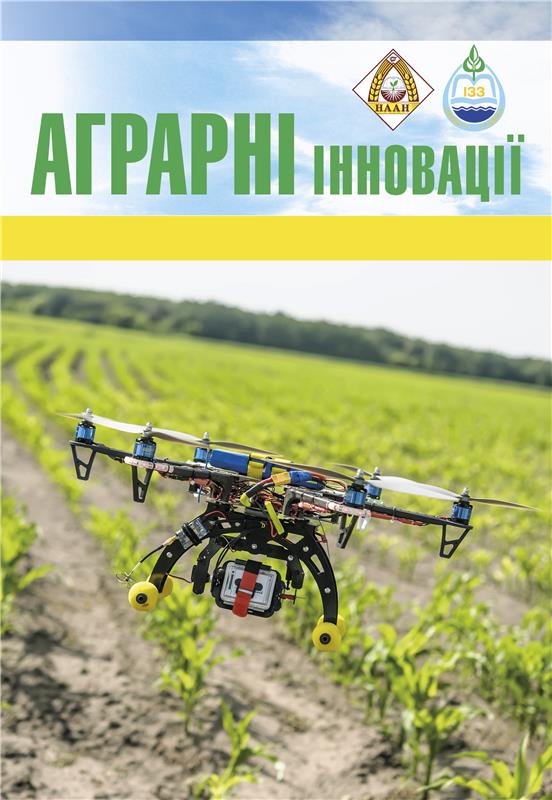WIDE ADAPTIVE CAPACITY OF SOFT WINTER WHEAT VARIETY LEHENDA BILOTSERKIVSKA – TARGETED INVOLVEMENT OF STEPPE AND FOREST-STEPPE ECOTYPES IN HYBRIDIZATION
Abstract
The purpose. Creation of new starting material and varieties of soft winter wheat by involving steppe and forest-steppe ecotypes in hybridization. Methods. The breeding process of creating the winter soft wheat variety Legend of Bilotserkivska included the following successive stages: development of the variety model, selection of initial forms, hybridization (Odeska 51 / Kyianka // Myronivska 33) – creation of synthetic material for selection, study of the selected material in breeding and control nurseries, preliminary and competitive variety testing, State scientific and technical expertise. The soft winter wheat was sown in the last days of the third decade of September and early October.Agricultural practices were common for the Forest-Steppe region of Ukraine. The statistical processing of the obtained biometric data was carried out according to A.T. Oprya, L.O. Dorohan-Pysarenko et al. (2014). Results. The pedigree of the new variety of soft winter wheat Legend of Bila Tserkva, the features of the preliminary variety testing of the breeding lines Lutestsens 436 and Lutestsens 437 on the pea predecessor were studied. Competitive variety testing of the line Lutestsens 437 was conducted on two predecessors pea and green manure, the results were compared with the average group standard, the indicators of which were formed by evaluating the varieties-standards Perlyna lisostepu, Bilotserkivska napivkarlykova, Podolianka. The distinctive features and approbation traits of the variety Lehenda bilotserkivska were established. Conclusions. Winter bread wheat varieties created by hybridizing the world's best genotypes are valuable material for crop breeding to expand genetic diversity and increase the productive and adaptive potential of the species. By purposeful involvement of steppe and forest-steppe ecotypes in intraspecific hybridization, a variety of soft winter wheat Lehenda bilotserkivska withhigh genetic potential for productivity and wide adaptability was created, which is confirmed by its inclusion in the State Register of Plant Varieties Suitable for Distribution in Ukraine and recommended for cultivation in the Forest-Steppe, Steppe and Polissya zones of Ukraine. The genotypic differences to extreme meteorological conditions of the studied years in the formation of yield and grain quality, winter hardiness and disease resistance were established.
References
2. Li F., Wen W., Liu J. et al. Genetic architecture of grain yield in bread wheat based on genome-wide association studies. BMC Plant Biology. 2019. № 19. Article 168.
3. Hatfield J. L., Beres B. L. Yield gaps in wheat: path to enhancing productivity. Frontiers in Plant Science. 2019. № 10. Article 1603.
4. Kristensen P. S., Jahoor A., Andersen J. R. et al. Genome-wide association studies and comparison of models and cross-validation strategies for genomic prediction of quality traits in advanced winter wheat breeding lines. Frontiers in Plant Science. 2018. № 9. Article 69.
5. Jaiswal V., Gahlaut V., Mathur S. et al. Identification of novel SNP in promoter sequence of TaGW2-6A associated with grain weight and other agronomic traits in wheat (Triticum aestivum L.). PLoS ONE. 2015. № 10(6). Article e0129400.
6. Li Q., Pan Z., Gao Y. et al. Quantitative trait locus (QTLs) mapping for quality traits of wheat based on high density genetic map combined with bulked segregant analysis RNA-seq (BSR-Seq) indicates that the basic 7S globulin gene is related to falling number. Frontiers in Plant Science. 2020. № 11. Article 600788.
7. Пшениця озима: ресурсний потенціал та технологія вирощування: монографія / Гамаюнова В. В., Корхова М. М., Панфілова А. В., Смірнова І. В., Коваленко О. А., Хоненко Л. Г. Миколаїв, 2021. 300 с.
8. Сидякіна О. В., Дворецький В. Ф. Продуктивність пшениці озимої залежно від фонів живлення в умовах Західного Полісся. Наукові горизонти. 2020. № 7(92). С. 45–52.
9. Лотиш О. Я. Стратегічний аналіз зернової галузі України: стан та перспективи розвитку. Інтелект ХХІ. 2018. № 3. С. 74–79.
10. Офіційний сайт Державної служби статистики України. URL: http://ukrstat.gov.ua
11. Бойко В. О., Бойко Л. О. Продовольча безпека та ризики для аграрного виробництва під час війни в Україні. Економіка та суспільство. 2022. № 41.
12. Настояща В. В. Зерновий комплекс України в контексті забезпечення продовольчої безпеки держави. Наукові записки. 2007. № 8. C. 235–239.
13. Спеціальна генетика сільськогосподарських кулmтур: навчальний посібник / Васильківський С. П., Вільчинська Л. А., Лозінський М. В., Сидорова І. М., Хоменко Т. М., Шох С. С. Біла Церква, 2011. 230 с.
14. Li W., Yang B. Translational genomics of grain size regulation in wheat. Theoretical and Applied Genetics. 2017. № 130 (9). Р. 1765–1771.
15. Литовченко А. О., Глушко Т. В., Сидякіна О. В. Якість зерна сортів пшениці озимої залежно від факторів та умов року вирощування на півдні Степу України. Вісник аграрної науки Причорномор’я. 2017. Вип. 3(95). С. 101–111.
16. Собко Т. О., Сірант Л. В., Лісова Г. М. Генетична різноманітність сортів пшениці м’якої ярої за локусами запасних білків. Фактори експериментальної еволюції організмів. 2018. Т. 23. С. 334–339.
17. Stewart B. A., Lal R. Increasing world average yields of cereal crops: it’s all about water. In Advances in Agronomy. 2018. Vol. 151. Р. 1–44.
18. Röder M., Thornley P., Campbell G., Bows-Larkin A. Emissions associated with meeting the future global wheat demand: A case study of UK production under climate change constraints. Environmental Science & Policy. 2014. № 39. Р. 13–24.
19. Моргун В. В., Топчій Т. В. Значення стійких сортів озимої пшениці, вивчення джерел і донорів стійкості до шкідників та основних збудників хвороб. Фізіологія рослин і генетика. 2018. Т. 50. № 3. С. 218–240.
20. Особливості визначення адаптивності селекційних ліній пшениці м’якої озимої в умовах центрального Лісостепу України: монографія / Демидов О. А., Замліла Н. П., Вологдіна Г. Б., Гуменюк О. В., Рисін А. Л. Київ: Компринт, 2023. 219 с.
21. Бойчук І. В. Обґрунтування підбору сортів пшениці озимої для умов південного степу України. Topical issues of the development of modern science: The 7th International scientific and practical conference. Sofia, Bulgaria: ACCENT. 2020. P. 151–161.
22. Литвиненко М. А. Реалізація генетичного потенціалу. Проблеми продуктивності та якості зерна сучасних сортів озимої пшениці. Насінництво. 2010. № 6. С. 1–6.
23. Василюк П. М., Уліч Л. І. Наукове обґрунтування після реєстраційних досліджень сортів. Вісник аграрної науки. 2013. № 1. С. 45–49.
24. Моргун В. В., Санін Є. В., Швартау В. В. Сорти та оптимальні системи вирощування озимої пшениці. Інститут фізіології рослин і генетики НАН України. Клуб 100 центнерів. Компанія «Сингента». 2012. С. 22–23.
25. Soko T., Bender C. M., Prins R., Pretorius Z. A. Yield loss associated with different levels of stem rust resistance in bread wheat. Plant Disease. 2018. Vol. 102(12). P. 2531–2538.
26. Sarto M. V. M., Sarto J. R. W., Rampim L. et al. Wheat phenology and yield under drought: a review. Austral. Journal Crop Science. 2017. Vol. 11 (8). P. 941–946.
27. Nazarenko M., Lykholat Y. Influence of relief conditions on plant growth and development. Dnipro university bulletin. Geology. Geography. 2018. № 26(1). P. 143–149.
28. Бурденюк-Тарасевич Л. А., Лозінський М. В. Принципи підбору пар для гібридизації в селекції озимої пшениці T. aestivum L. на адаптивність до умов довкілля. Фактори експериментальної еволюції організмів. 2015. Т. 16. С. 92–96.
29. Лозінський М. В., Устинова Г. Л., Ображій С. В., Діхтяренко В. М. Особливості успадкування маси зерна головного колосу за гібридизації різних за скоростиглістю сортів пшениці м’якої озимої. Аграрні інновації. 2021. № 9. С. 61–68.
30. Бурденюк-Тарасевич Л. А., Дубова О. А., Чайка А. М, Лозінський М. В. Легенда білоцерківська – сильний за якість сорту мיякої пшениці озимої інтенсивного типу. Аграрна наука – виробництво. Науково-інформаційний бюлетень завершених наукових розробок. Київ, 2019. С. 15.
31. Статистика: навчальний посібник / Опря А. Т., Дорогань-Писаренко Л. О., Єгорова О. В., Кононенко Ж. А. К. : Центр учбової літератури, 2014. 536 с.
32. Чебаков М. П., Лебедєва Г. Д., Власенко В. А. Використання вихідного матеріалу пшениці озимої західноєвропейського екотипу та його роль у створенні високо адаптивних сортів. Сортовивчення та охорона прав на сорти рослин. 2006. № 3. С. 5–17.
33. Лифенко С. П. Історія генетики і селекції пшениці в Україні. Виступ на VII з’їзді Укр. тов-ва генетиків і селекціонерів ім. М. І. Вавилова; АР Крим, с. Берегово, 4 червня 2002 р. Крим, 2002. 1 с.
34. Власенко В. А., Кочмарський В. С., Колючий В. Т. Селекційна еволюція миронівських пшениць. Миронівка, 2012. 330 с.
35. Кунах В. А. Розвиток генетики в Національній академії наук України (до 90-річчя від часу заснування Української академії наук). Вісник Українського товариства генетиків і селекціонерів. 2008. Т. 6. № 1. С. 3–43.






